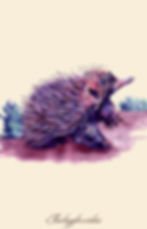"I Am Not A Hedgehog", The Echidna Story
- Martha Iserman
- Mar 6, 2020
- 2 min read
I'm finally back to my Australian Animals series! We have another monotreme this time, and like the platypus, it's a very strange animal.
The Echidna
And their babies look just as fake!
The title of this post is because I had a picture in my head of echidnas as slightly larger hedgehogs with Australian accents. That is until I almost stepped on one during a hike on Phillip Island.
Based on this footage I'm quitting everything and becoming a nature documentarian.
(Call me Planet Earth!)
This lil guy was trucking it down the path without any real concern for us which allowed for plenty of time to observe it. I have to say, the best part is the wobbly walk and the oddly backward-facing feet.
So now that I'm best friends with the Echidnas, here are some fun facts about everyone's second-favorite Monotreme.
First off let's address the term "fun facts". Every article I read about Echidna's used the phrase and then included a few uncomfortable tidbits about these spikey fellas which I want
to get out of the way up top.
These are slightly NSFW, but hey, that's nature!
-Number One, Male echidnas have a four-headed.... appendage. To be fair, the females have a two-branched reproductive tract, so at least they're sticking with even numbers.
-Number Two, and this is the problematic one, the males will form what all of the publications I read called a "Mating Train" when seeking out females. I did not like that phrase, especially after the phrase "fun facts".
Now that's out of the way, here's the warm and fuzzy stuff.
- They are monotremes which means they are egg-laying mammals along with the mighty platypus. They are native to Australia, Tasmania, and the island of New Guinea.
-Their spines are actually long, tough modified hair follicles. When attacked they roll up into a ball much like a hedgehog, or that one kid from elementary school on the playground.
-Between the spines, they have thick regular fur to keep them warm and give the appearance of cuddliness.
- Echidnas are low and slow. They have very long lifespans due to their low body temperature and slow metabolism, up to 50 years!
This guy voted for Dukakis
-They're built for digging which explains the clawed backward-facing feet. Their snout is used to burrow for ants, termites, worms and insect larvae.
-They are the proud host of the world's largest flea species, Bradiopsylla echidnae (aka the echidna flea) at 4mm or .15 inches long.
-There is a species named after Sir David Attenborough, the Long-beaked echidnas native to New Guinea (Z.attenbourough). If you know me personally you know I love me some S.D.A. and have a framed picture of him in my studio.

So Echidnas are randy little burrowers who don't give a hoot about your hike and I feel really fortunate to have seen one in the wild! It caused me to start my painting over since it gave me a better perspective on the size and overall look of the mighty Echidna!

Only two more Australian Animals in the series! Stay tuned for my Cockatoo painting, coming up in the next few days.